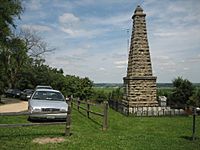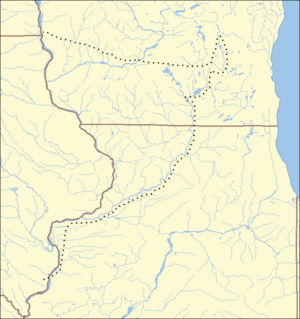Battle of Kellogg's Grove facts for kids
Quick facts for kids Battle of Kellogg's Grove |
|||||||
|---|---|---|---|---|---|---|---|
| Part of the Black Hawk War | |||||||
 Monument and graves located in a park near Kent, Illinois. |
|||||||
|
|||||||
| Belligerents | |||||||
| Sauk Fox Kickapoo |
|||||||
| Commanders and leaders | |||||||
| John Dement Adam W. Snyder Samuel Whiteside |
Black Hawk | ||||||
| Strength | |||||||
| approximately 300 | 80 | ||||||
| Casualties and losses | |||||||
| 8 KIA 3 WIA |
at least 15 KIA | ||||||
The Battle of Kellogg's Grove refers to two small fights, or skirmishes, that happened during the Black Hawk War. These battles took place in what is now Stephenson County, Illinois, near a place called Kellogg's Grove.
The first fight, on June 16, 1832, is also known as the Battle of Burr Oak Grove. During this skirmish, soldiers from the Illinois militia fought against a group of at least 80 Native Americans. Three militia soldiers were killed. The second battle happened nine days later, on June 25. A larger group of Sauk and Fox warriors, led by Black Hawk, attacked a group of militia soldiers. Five militia members died in this fight.
The second battle is famous because Abraham Lincoln was involved. He was a soldier in the Illinois militia at the time. He arrived the day after the battle and helped bury the dead. Years later, he spoke about what he saw. The Battle of Kellogg's Grove was the last battle of the Black Hawk War fought in Illinois.
Contents
What Caused the Battle?
The Black Hawk War started because of a disagreement over land. In 1804, a treaty was signed between the governor of Indiana Territory and some Sauk and Fox leaders. This treaty said that the Sauk and Fox tribes would leave their lands in Illinois. They were supposed to move west of the Mississippi River by 1828.
However, the Sauk leader Black Hawk and others disagreed with this treaty. They said that the full tribal councils were not asked. They also claimed that the leaders who signed the treaty did not have the right to give away the land. Black Hawk was upset about losing his birthplace. From 1830, he led his group, called the "British Band," back into Illinois several times. Each time, he was convinced to return west without any fighting.
In April 1832, Black Hawk tried again. He believed other tribes and the British would help him. He led about 1,000 warriors and their families into Illinois. But he found no allies. He then tried to go back to Iowa. However, events quickly led to the Battle of Stillman's Run. After that, more battles and attacks happened. The militias from Michigan Territory and Illinois gathered to find Black Hawk's band.
Before the Fight
| Map of Black Hawk War sites Symbols are wikilinked to article |
A few days before the second Battle of Kellogg's Grove, a raid happened near Bureau Creek. Major John Dement and his soldiers were sent to protect settlers. They also needed to find out if Native Americans were in the area. They were told to report to Colonel Zachary Taylor at Dixon's Ferry.
On June 22, Dement reached Dixon's Ferry and reported to Taylor. Taylor ordered him to cross the Rock River. He was to set up his main camp at Kellogg's Grove. Dement had 140 new soldiers. He went to the grove to replace another group of soldiers who had left the small fort there. The soldiers who left had fought with Native Americans a few times and had lost.
Major Dement's group crossed the Rock River on June 24. They reached the small fort at Kellogg's Grove and camped for the night. The day before, June 24, Black Hawk and his band had attacked Apple River Fort. During the Battle of Apple River Fort, the Sauk surrounded the fort for most of the day. Other warriors were sent to find food, horses, and supplies. These were much needed by Black Hawk's group. The next day, Black Hawk's group would reach Kellogg's Grove. There, they would fight Dement's militia.
The Battles
First Battle of Kellogg's Grove
The first Battle of Kellogg's Grove happened on June 16, 1832. It is also called the Battle of Burr Oak Grove. Soldiers from Captain Adam Wilson Snyder's company fought against a group of about 80 Kickapoo warriors. Three militia soldiers were killed, and six Kickapoo warriors died.
On the night of June 15, Captain Snyder and his men were at Kellogg's Grove. They found out that Native Americans were in the area. During the night, a horse was stolen. The next day, June 16, Snyder and his men chased the Native Americans. They found and killed four Native Americans. During the fight, a soldier named William B. Mecomson was badly hurt.
The militia soldiers put the wounded man on a stretcher. They started to carry him back to the Kellogg cabin. On the way, Mecomson asked them to stop and rest. The group stopped, and some men went to get water. The rest waited with Mecomson. While they waited, a large group of Native Americans appeared. A short battle followed, and two more militia members were killed. After the fight, the Native Americans left. The militia soldiers returned to the Kellogg cabin and buried their dead the next day.
Second Battle of Kellogg's Grove
The Second Battle of Kellogg's Grove took place on June 25, 1832. Major John Dement and his men were camped at Kellogg's Grove on June 24. They learned that a large group of Native Americans was nearby. The battle was between Black Hawk and his war chiefs Neapope and Weesheet against Dement's militia soldiers. Dement's group had been looking for groups of warriors sent by Black Hawk. Their search led them to Kellogg's Grove.
During the night, three of the militia's horses wandered off. The next day, June 25, three men went to find the horses. The rest stayed at the cabin. Seven Native American warriors appeared in the distance. The soldiers immediately chased them into the woods. They did not report what they saw to Dement first. The Native American warriors had set a trap in the forest. This was a tactic they had used before in the war.
The militia chased the Native Americans into the woods. As they entered, the Native Americans opened fire. Two militia men were killed instantly, and another was wounded. The militia pulled back and formed a battle line. But the Native American forces kept attacking. The rest of Dement's company tried to help the outnumbered militia. But they could not push back the Native American warriors. Black Hawk's group attacked the militia again. This forced the tired soldiers to fall back to the Kellogg cabin and barn.
As the militia retreated, the three men who had gone to find their horses returned. They were also killed by the Native American forces. The Native Americans continued to attack the barn and cabin. Their attacks did not stop. During the battle, about 25 horses were killed. Finally, the Native American forces left. They left nine of their own dead behind. The June 25 battle was the last fight of the Black Hawk War on Illinois soil. Dement's company lost five men, and three more were wounded. Many horses were also killed.
That night, American soldiers arrived to help. They were led by General Alexander Posey. He decided not to chase the attackers. Instead, he reported the situation to Colonel Zachary Taylor. Black Hawk later said that if Posey had attacked him, it would have been a major defeat for his group and ended the war. Dement believed there were more Native Americans at Kellogg's Grove than in any other battle during the war. The next day, more soldiers arrived when Captain Jacob Early's group reached the grove.
Abraham Lincoln's Part
Abraham Lincoln's time as a soldier in the Black Hawk War has been talked about a lot. Two main battle sites are linked to Lincoln after the fighting. Many sources say that on June 26, 1832, the morning after the second battle, Captain Jacob M. Early's soldiers arrived at Kellogg's Grove. They were there to help bury the dead. Abraham Lincoln was one of these soldiers.
Lincoln helped with the burial. Later, he spoke about what he experienced. This quote has been linked to both the battle at Kellogg's Grove and the fight at Stillman's Run:
I remember just how those men looked as we rode up the little hill where their camp was. The red light of the morning sun was streaming upon them as they lay head towards us on the ground. And every man had a round red spot on top of his head, about as big as a dollar where the redskins had taken his scalp. It was frightful, but it was grotesque, and the red sunlight seemed to paint everything all over. I remember one man had on buckskin breeches.
This quote from Lincoln appeared in books by William H. Herndon and Jesse W. Wiek, and also in Carl Sandburg's biography of Lincoln. While Lincoln's presence at Stillman's Run was still being checked in 2003, his presence at Kellogg's Grove has been confirmed by several sources.
Lincoln made a funny comment in a speech in 1848 to the U.S. Congress. He talked about his service in the Black Hawk War. He even mentioned Stillman's Run by name:
By the way Mr. Speaker, did you know that I am a military hero? Yes sir, in the days of the Black Hawk War I fought, bled and came away . . . I was not at Stillman's defeat, but I was about as near it as Cass was Hull's surrender, and, like him, I saw the place very soon afterwards.
A monument was built in 1901 in Stillman Valley, Illinois, to remember the battle there. The monument has a marble plaque that mentions Lincoln. It says, "The presence of soldier, statesman, martyr, Abraham Lincoln assisting in the burial of these honored dead has made this spot more sacred."
What Happened After
Sources do not fully agree on who won the battle. The Battle of Kellogg's Grove, like many fights in the Black Hawk War, did not have a clear plan. Some early reports said the battle was a complete victory for the state militia. They said the Sauk lost 15 warriors, while the militia only lost 5 men.
However, the Illinois Department of Natural Resources says that about 50 Sauk warriors defeated the 300 or so untrained white soldiers. This means the outcome is still debated.
The battle site at Kellogg's Grove was added to the U.S. National Register of Historic Places on June 23, 1978. The site includes a public park with a stone monument and a memorial cemetery. The cemetery holds the remains of the militia soldiers who died in both battles at Kellogg's Grove. The men were first buried in different spots around the grove. But in the 1880s, local farmers worked together. They gathered the remains of the Black Hawk War dead and buried them in one spot under a memorial.



